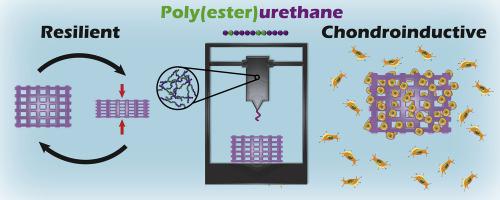Materials Today Bio ( IF 8.2 ) Pub Date : 2020-04-13 , DOI: 10.1016/j.mtbio.2020.100051 S Camarero-Espinosa 1, 2 , C Tomasina 1, 2 , A Calore 1, 3 , L Moroni 1

|
Articular cartilage was thought to be one of the first tissues to be successfully engineered. Despite the avascular and non-innervated nature of the tissue, the cells within articular cartilage – chondrocytes – account for a complex phenotype that is difficult to be maintained in vitro. The use of bone marrow–derived stromal cells (BMSCs) has emerged as a potential solution to this issue. Differentiation of BMSCs toward stable and non-hypertrophic chondrogenic phenotypes has also proved to be challenging. Moreover, hyaline cartilage presents a set of mechanical properties – relatively high Young's modulus, elasticity, and resilience – that are difficult to reproduce. Here, we report on the use of additive manufactured biodegradable poly(ester)urethane (PEU) scaffolds of two different structures (500 μm pore size and 90° or 60° deposition angle) that can support the loads applied onto the knee while being highly resilient, with a permanent deformation lower than 1% after 10 compression-relaxation cycles. Moreover, these scaffolds appear to promote BMSC differentiation, as shown by the deposition of glycosaminoglycans and collagens (in particular collagen II). At gene level, BMSCs showed an upregulation of chondrogenic markers, such as collagen II and the Sox trio, to higher or similar levels than that of traditional pellet cultures, with a collagen II/collagen I relative expression of 2–3, depending on the structure of the scaffold. Moreover, scaffolds with different pore architectures influenced the differentiation process and the final BMSC phenotype. These data suggest that additive manufactured PEU scaffolds could be good candidates for cartilage tissue regeneration in combination with microfracture interventions.
中文翻译:

具有软骨诱导特性的增材制造的,高弹性,弹性和可生物降解的聚(氨基甲酸酯)聚氨酯支架,用于软骨组织工程。
关节软骨被认为是成功改造的首批组织之一。尽管组织具有无血管和非神经支配的性质,但关节软骨内的细胞(软骨细胞)仍具有复杂的表型,很难在体外维持。骨髓来源的基质细胞(BMSC)的使用已成为解决此问题的潜在方法。BMSC向稳定和非肥大性软骨形成表型的分化也被证明是具有挑战性的。此外,透明软骨具有一系列机械特性-相对较高的杨氏模量,弹性和弹性-难以复制。这里,我们报告了使用两种不同结构(孔径为500μm,沉积角度为90°或60°)的增材制造的可生物降解的聚(酯)聚氨酯(PEU)支架的使用情况,该支架可以支撑施加在膝盖上的负载,同时具有很高的弹性, 10个压缩松弛周期后的永久变形低于1%。此外,如糖胺聚糖和胶原蛋白(特别是胶原蛋白II)的沉积所显示,这些支架似乎促进BMSC分化。在基因水平上,骨髓间充质干细胞显示软骨生成标记(如胶原蛋白II和Sox三重奏)上调至高于或类似于传统沉淀培养的水平,胶原蛋白II /胶原蛋白I的相对表达为2-3,具体取决于支架的结构。此外,具有不同孔结构的支架影响分化过程和最终的BMSC表型。这些数据表明,加有添加剂的PEU支架与微骨折干预相结合,可能是软骨组织再生的良好候选者。


























 京公网安备 11010802027423号
京公网安备 11010802027423号